Real Space Visualization of Competing Phases in La0.6Sr2.4Mn2O7 Single Crystals
Abstract
Correlated quantum materials are expected to provide the foundation for the next generation of information or energy technologies. A key feature of these materials is the proximity of multiple ground states close in energy, which results in the ability to tune properties with small changes in an external parameter such as magnetic field, composition, or temperature. For example, the colossal magnetoresistance exhibited by manganites is related to charge and orbital ordering and results from a metallic ferromagnetic phase in proximity to a paramagnetic insulating phase. The presence of competing ground states, at the heart of the physics and functionality of these materials, often results in nanoscale phase separation. Probing nanoscale phase separation with conventional diffraction techniques alone is not adequate, particularly when the domains are small or nanosized. In the present work we use a scanning transmission electron microscopy image-based technique of picometer precision strain maps (PPSM) to directly visualize the competing nanoscale phases with charge and orbital ordering in a double-layer manganite. This work underscores the role of subtle structural distortions in determining the electron physics in correlated quantum materials and provides insights into designing new functionalities via spatially tuning multiple competing ground states.
- Authors:
-
- Oak Ridge National Lab. (ORNL), Oak Ridge, TN (United States). Materials Science and Technology Division
- Argonne National Lab. (ANL), Argonne, IL (United States). Materials Science Division
- Oak Ridge National Lab. (ORNL), Oak Ridge, TN (United States). Center for Nanophase Materials Science (CNMS)
- Publication Date:
- Research Org.:
- Oak Ridge National Lab. (ORNL), Oak Ridge, TN (United States); Argonne National Lab. (ANL), Argonne, IL (United States)
- Sponsoring Org.:
- USDOE Office of Science (SC), Basic Energy Sciences (BES) (SC-22). Materials Sciences & Engineering Division; USDOE Office of Science (SC), Basic Energy Sciences (BES)
- OSTI Identifier:
- 1482431
- Alternate Identifier(s):
- OSTI ID: 1488565
- Grant/Contract Number:
- AC05-00OR22725; AC02-06CH11357
- Resource Type:
- Accepted Manuscript
- Journal Name:
- Chemistry of Materials
- Additional Journal Information:
- Journal Volume: 30; Journal Issue: 21; Journal ID: ISSN 0897-4756
- Publisher:
- American Chemical Society (ACS)
- Country of Publication:
- United States
- Language:
- English
- Subject:
- 36 MATERIALS SCIENCE
Citation Formats
Zheng, Qiang, Schreiber, Nathaniel J., Zheng, Hong, Yan, Jiaqiang, Mcguire, Michael A., Mitchell, J. F., Chi, Miaofang, and Sales, Brian C. Real Space Visualization of Competing Phases in La0.6Sr2.4Mn2O7 Single Crystals. United States: N. p., 2018.
Web. doi:10.1021/acs.chemmater.8b03589.
Zheng, Qiang, Schreiber, Nathaniel J., Zheng, Hong, Yan, Jiaqiang, Mcguire, Michael A., Mitchell, J. F., Chi, Miaofang, & Sales, Brian C. Real Space Visualization of Competing Phases in La0.6Sr2.4Mn2O7 Single Crystals. United States. https://doi.org/10.1021/acs.chemmater.8b03589
Zheng, Qiang, Schreiber, Nathaniel J., Zheng, Hong, Yan, Jiaqiang, Mcguire, Michael A., Mitchell, J. F., Chi, Miaofang, and Sales, Brian C. Mon .
"Real Space Visualization of Competing Phases in La0.6Sr2.4Mn2O7 Single Crystals". United States. https://doi.org/10.1021/acs.chemmater.8b03589. https://www.osti.gov/servlets/purl/1482431.
@article{osti_1482431,
title = {Real Space Visualization of Competing Phases in La0.6Sr2.4Mn2O7 Single Crystals},
author = {Zheng, Qiang and Schreiber, Nathaniel J. and Zheng, Hong and Yan, Jiaqiang and Mcguire, Michael A. and Mitchell, J. F. and Chi, Miaofang and Sales, Brian C.},
abstractNote = {Correlated quantum materials are expected to provide the foundation for the next generation of information or energy technologies. A key feature of these materials is the proximity of multiple ground states close in energy, which results in the ability to tune properties with small changes in an external parameter such as magnetic field, composition, or temperature. For example, the colossal magnetoresistance exhibited by manganites is related to charge and orbital ordering and results from a metallic ferromagnetic phase in proximity to a paramagnetic insulating phase. The presence of competing ground states, at the heart of the physics and functionality of these materials, often results in nanoscale phase separation. Probing nanoscale phase separation with conventional diffraction techniques alone is not adequate, particularly when the domains are small or nanosized. In the present work we use a scanning transmission electron microscopy image-based technique of picometer precision strain maps (PPSM) to directly visualize the competing nanoscale phases with charge and orbital ordering in a double-layer manganite. This work underscores the role of subtle structural distortions in determining the electron physics in correlated quantum materials and provides insights into designing new functionalities via spatially tuning multiple competing ground states.},
doi = {10.1021/acs.chemmater.8b03589},
journal = {Chemistry of Materials},
number = 21,
volume = 30,
place = {United States},
year = {Mon Oct 22 00:00:00 EDT 2018},
month = {Mon Oct 22 00:00:00 EDT 2018}
}
Web of Science
Figures / Tables:
 Figure 1: Local competing and interpenetrating nanoscale domains with varying La contents in LSMO-0.7 single crystal. (a) A typical atomic-resolution HAADF-STEM image along the [001] zone axis. (b) Fast Fourier transform (FFT) pattern of (a) reveals appearance of structural modulations in this crystal. Two sets of satellite spots neighboring (000)more »
Figure 1: Local competing and interpenetrating nanoscale domains with varying La contents in LSMO-0.7 single crystal. (a) A typical atomic-resolution HAADF-STEM image along the [001] zone axis. (b) Fast Fourier transform (FFT) pattern of (a) reveals appearance of structural modulations in this crystal. Two sets of satellite spots neighboring (000)more »
Figures / Tables found in this record:

 Search WorldCat to find libraries that may hold this journal
Search WorldCat to find libraries that may hold this journal